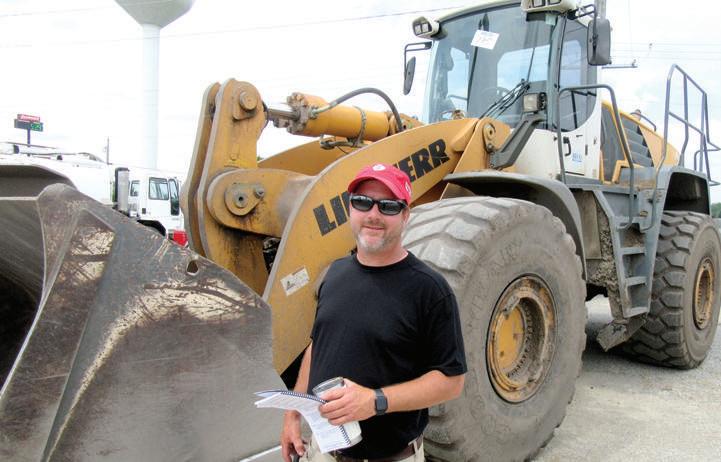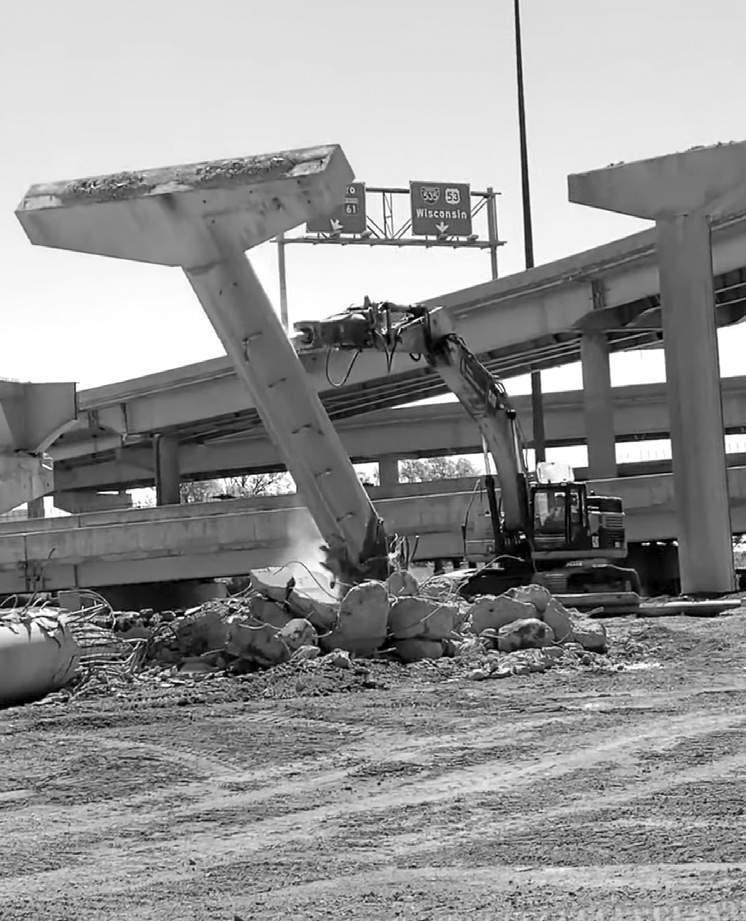
11 minute read
YODER & FREY’S OHIO AUCTION ATTRACTS STRONG BIDDING
Yoder & Frey conducted an auction on June 1 at the company’s United States headquarters in North Baltimore (Findlay), Ohio. On site buyers competed with strong online bidding for the selection of excavators, wheel loaders, work trucks and a variety of other machines and support equipment.
Yoder & Frey’s next scheduled auction will be held at its Florida auction site located at 654 West Southport Rd. in Kissimmee, Fla., on Aug. 31.
For more information, visit yoderandfrey.com. CEG (All photographs in this article are Copyright 2022 Construction Equipment Guide. All Rights Reserved.)

(L-R): After landing the winning bid on a grader, Dick Helminiak of Dick Helminiak and Sons Inc. caught up with Rick and Rhett Buehler of Buehler Asphalt and Paving. Rodney (L) and Aiden Kiefer of Rodney Kiefer Construction LLC were pleased to have placed the winning bid on this Caterpillar 311D excavator.


Meinert Excavating and Son’s Tim Meinert looks over the excavators that were up for bid. Rick Hohenbrink of Hohenbrink Excavating bought this Werk Brau bucket at the auction.


TPI from page 82
geo-grid to bulk up the poor geology and support a highway carrying 80,000 vehicles per day.
From the construction side of the project, every piece of concrete, asphalt and bridge structure must be removed and replaced under traffic conditions.
Road and lane closures, detours and traffic switchbacks alone are complex and a juggling challenge for traffic engineers to stay one step ahead of construction crews. In September 2021, a major milestone in traffic management was met when crews switched southbound I-35 traffic onto Lower Michigan Street in Duluth to give demolition crews a free reign on the northbound lanes to begin bridge demolitions.
Concrete recycling is huge on this project. All the concrete from road and bridge demolitions is crushed on site and recycled as part of the new base for mainline I-35.
To bring this project to an end, the construction team alone will move approximately 30 pieces of heavy equipment in and out of this site including 150-ton Manitowoc cranes; 150-ton MLC and American cranes; and Tadano Mantis and Grove hydro cranes. A variety of Cat excavators, dozers, loaders and graders are on site for excavation and grading operations.
The construction team relies on Fabick Rents, Ziegler Cat, Kraemer Construction and United Rentals to fill in equipment gaps.
Sub-contractors will move in dozens of pieces of additional heavy equipment during the three-year project.
Despite these challenges and working around Covid impacts and some late material shipping, construction has been going well.
“Overall, the project has been going well. We have a lot of talented people on the team up here between the Ames-Kraemer joint venture, MnDOT and the designers and the city of Duluth. Everybody has done a good job,” said Matt Huber, Kraemer North America structures construction manager.
Pete Marthalar, MnDOT construction engineer echoed those thoughts.
“Everything is going well. We have a good team atmosphere between MnDOT and the contractors. I’ll credit the contractors for being a part of the design which was instrumental in fostering that relationship,” Marthalar said.
Both Marthalar and Huber agree that the geology corrections have been one of the biggest challenges on this project and led designers to take a different approach to the traditional roadbed design.
“Historically this was an industrial area filled with contaminated soil and structurally deficient soil and it also sits on a coastal wetland area,” said Marthalar. “What we’re dealing with here is material that doesn’t have much structural capability. Because it is a coastal wetland area it has a lot of organic material in it and a lot of different strata from sand to organics with a high-water table.
“With the geotechnical issues we have here we can’t put the highway on the ground like the typical highway or it would fall apart in short order. The solution we went with is to install grout columns into the soil down to a competent elevation layer. Then we will place a reinforced load platform on them composed of alternating layers of aggregate and geo-grid to a specified thickness.
Though more work goes into strengthening the road base over more traditional methods, this approach has its advantages. It cuts out more costly bridge construction and eliminates future winter deicing operations, general bridge deck maintenance and future bridge replacement costs, Marthalar added.
The contaminated soil dominates the environmental controls on this project and features a temporary water treatment system that has been running while crews worked through the cold and raw winter season.
“The contamination is always difficult to work with; just making sure we handle and manage it in the proper way. Between the contaminated soil and the contaminated water that goes along with that, all the water is sent through a temporary treatment system before it goes to the Western Lake Superior Sanitary District [WLSSD]. We have the dewatering system up and running full time pumping 400 gallons per minute.” With nearly two miles of temporary pipe placed, “This causes a challenge in the winter trying to keep the water from freezing and maintaining the flow in the pipes,” Huber said.
The secondary components of this project led to further challenges and complex construction stages.
Besides very limited lay-down and storage space and complex earth retention staging sequences to keep ramps open as bridges came down, one of the most challenging elements was the construction of a box culvert.
This culvert is combining two, existing trout streams into one at and under I-35 and a set of nearby railroad tracks to empty into the St. Louis Bay. The new, combined stream will add capacity and ease future flooding.
Here, construction on a four-cell cast-inplace box culvert, 505 ft. long and 56.5 ft. wide, has continued through a very raw and cold winter and under live traffic conditions. The complexity lies in keeping I-35 and the nearby railroad tracks open to vehicular and train traffic while culvert construction continues below.
Just this piece of the overall project was an immense and challenging undertaking and a project with a one-year construction schedule.
“To build the earth retention system is challenging because the footings are under water, so we had de-watering going on all winter. The weather has been an issue,” Marthalar said.
Elaborating further, Marthalar said the installation and constant shifting of steel piling and timber lagging to support the infrastructure above as construction progressed required 12 construction stages and excavations 50 ft. deep.
Along with these challenges, for Huber it’s the large scale of the project that has been interesting.
“Just being able to work with the owner then also being integrated with the city of Duluth and the BNSF railroad and just seeing how all parties can work together to make this project progress and go well has been interesting,” he said.
“The challenge of the geo-technical side of things is interesting and unique because you don’t see a lot of that. Trying to figure it out because we don’t have a lot of back history on the soil,” said Marthalar.
“It’s a lot different from previous projects we’ve seen not just for me, but the designers and MnDOT. Just being able to work through these challenges has been interesting,” Huber said.
As crews swing into the current construction season, they are expecting to open the new northbound I-35 to southbound I-535 connection and the new northbound I-535 to northbound I-35 connection this coming October.
Work on the remaining road configurations will continue into November 2023.




Frequent site inspections, regular safety meetings and rigorously enforced site safety standards supplemented with real-time data collection systems are suggested.
SAFETY from page 90
Flammable materials pose an inherent danger on the construction site. Solvents, liquid petroleum gas and adhesives pose multiple risks ranging from flammability and combustion to inhalation dangers, said Flynn.
Such materials must be stored and used in adequately ventilated spaces, he continued.
Simple skin contact with these materials can cause injury, said Flynn. They’re often more dangerous when inhaled due to the lack of or failure to use proper respiratory protection.
Foot injuries are a very common occurrence on construction sites, especially from falling objects. But there are many other causes and types of injuries.
Rhoades Legal notes that in addition to electrical shock, workers can suffer broken bones, punctures, cuts and lacerations, burns and sprains all involving the feet and negligence.
The law firm noted that workers can be crushed or suffer broken foot bones due to falling objects, moving vehicles and being trapped or caught between objects.
Punctures of the sole of the foot are caused by loose nails, sharp metal or glass objects.
“Puncture wounds can easily get infected if not treated promptly. You can even get tetanus from a puncture injury,” according to the legal team.
Cuts and lacerations of the feet can be caused by chainsaws, rotary mowers and unguarded or improperly guarded heavy machinery.
Foot-related burn injuries can result from splashing molten metal, chemical spills, contact with fire and flammable or explosive materials.
Electrical shock is caused by static electricity, contact with sources of electricity, including exposed hot wiring or wiring that is not properly grounded.
Finally, sprains can happen in slip and fall accidents. A worker could slip and fall on scaffolding or from wearing improper footwear.
Maintaining Safe Work Sites
Many local jurisdictions provide legal means to compensate injured workers, but both site owner and contractor can be proactive by integrating a mix of strictly enforced site safety practices, OSHA regulations and simple common sense, said Flynn.
“Comprised of wireless onsite sensors coupled with data collection nodes, such systems streamline the structural engineer’s ability to monitor the entire building site and anticipate problems before they arise,” said Flynn. “These systems can be customized to monitor material storage and the location and movement of workers throughout the site, thereby giving the engineer the ability to anticipate and prevent dangerous or even deadly accidents before they happen.”
What simple common-sense measures can be implemented on the job site? The list is long, but Rhoades refers to OSHA’s rules for preventing workplace injuries: • Workers must wear safety shoes when working in locations where there is a risk of slipping and falling or objects piercing the sole. • Protective footwear must meet ANSI Z4 or have equivalent design requirements. Impact and compression protection are provided by all ANSI-approved shoes.
Shoes or boots may need to have special electrical conductivity insulation or other non-conductive protective material in order to prevent electrical shock.
Chemical-resistant boots may be required to protect against caustic, reactive, toxic or corrosive substances during cleaning or surface preparation.
Slip-resistant shoes should always be worn in any type of construction or production facility environment, but especially if the worker will have to be in icy or rainy weather conditions.
Many construction work settings require boots with toe caps and puncture-proof soles. Non-slip soles, chemical-resistant materials, insulation or other protective features may be required in your profession.
Grant Law Office noted the adoption of additional safety precautions to reduce the risk of injury specifically from falling objects on the construction site: • Always wear protective gear, such as helmets, goggles and hard-toe boots. Avoid hazardous areas for falling materials. • Never walk or stand under heavy equipment, such as a front loader, hoist or crane, particularly when it is carrying a load. • Use the proper equipment for the job at hand. Never stack materials or objects too high. And inspect equipment and tools before using them. • Never use improperly maintained or faulty equipment or tools; never exceed the lifting capacity of a hoist, crane or lift; and secure tools and equipment properly when working overhead. CEG








